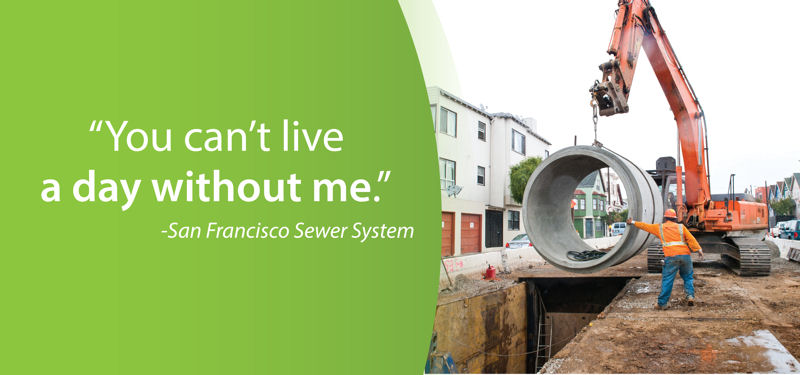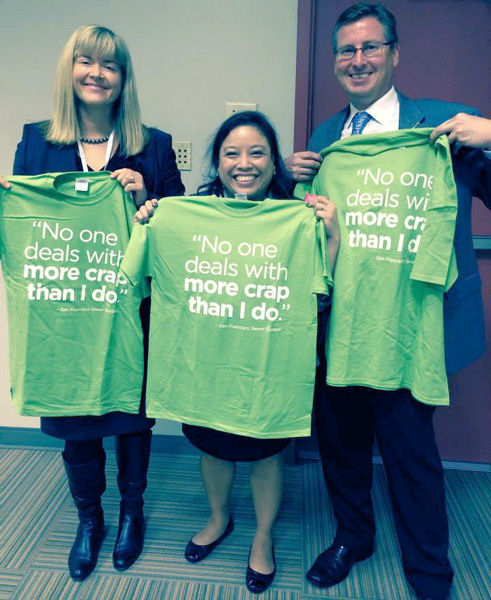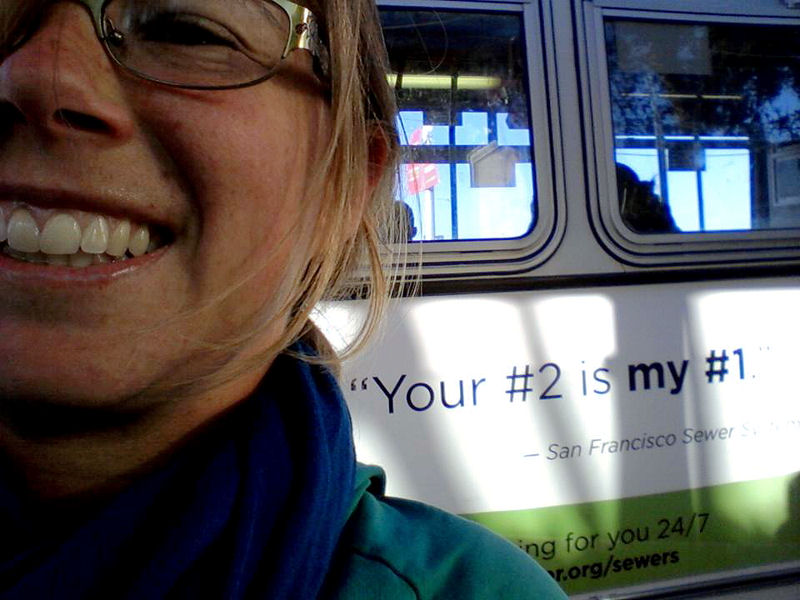
San Francisco Public Utilities Commission has given its sewer a voice through its public messaging campaign. Photo courtesy of the San Francisco Public Utilities Commission.
Advanced wastewater treatment systems around the world operate virtually undercover. They carry away wastewater, treat it to high standards, and release it back into the environment undetected by most customers. But, the San Francisco Public Utilities Commission sewer system is speaking out to educate about the value of its services.
Taglines, such as “You can’t live a day without me,” and “Your #2 is my #1,” have been appearing around San Francisco since October. The commission shares facts about its pipes, treatment capacity, and service area as well as its problems with clogs. It also uses its website to connect the public to more learning opportunities, including its monthly treatment facility tours.
The commission even gives the sewer system a voice: “I know you probably don’t think about me much, but I surely think about you. Every day, my friends and I make sure that all of my important parts continue functioning like a well-oiled machine. As your sewer system, I take my job seriously. That is why public health is my first priority.”

From left, Karen Kubick from the commission, and Christine Radke and Rick Warner both representing the Water Environment Federation (Alexandria, Va.) hold shirts with the campaign’s humorous taglines. Photo courtesy of the San Francisco Public Utilities Commission.
The commission had help crafting these messages. It worked with a public relations company to devise this unique outreach campaign. Together, they decided to make the message into something humorous that would get people talking, help them learn about the system, and open up a new dialogue between the public and commission through social media, said Lily Madjus, communications manager for the commission.
“It’s not just us putting information online and people seeing it, it’s more of people knowing we’re there and they know that we can interact with them and give them important information at the time they need it,” Madjus said.
The outreach campaign that personifies the system began in October as part of a public engagement effort for Phase 1 of the commission’s Sewer System Improvement Program. The commission wanted to spread the word about the value of the system and link this message to several projects.
The campaign included advertisements featuring taglines and the commission’s Web address on buses and trains, on social media sites, and in local newspapers. Because people often overlook wastewater service, the challenge was connecting in a way that resonates and relays the importance of the service. Together, the commission and its public relations company decided the straightforward and humorous message would be the best strategy.

Jessica Arnett took a photo of herself with one of the campaign advertisements on a local bus and shared it on Facebook. Photo courtesy of Arnett.
The campaign struck a chord with local citizens. They began taking pictures of the advertisements and sharing them on Facebook and Twitter. This inspired the commission to encourage this sharing by starting a giveaway to those sharing photos of the advertisements via Facebook, Twitter, and Instagram. The prize for October participation was a water bottle or T-shirt featuring either the commission’s logo or the advertisement’s taglines, so that customers could continue showing their pride in the treatment system, Madjus said.
“It’s definitely turned the corner in terms of the type of engagement we’ve had with our followers and our customers,” Madjus said. While the commission always has had good rapport with customers, they now are asking different questions and engaging in new conversations on social media, she explained. “This really allows us to get at the heart of what our sewer system does,” she said. For example, after a recent storm one customer posted a thank you note on the commission’s Facebook page for making sure streets hadn’t flooded.
“That’s kind of the awareness that we want and the interaction we want,” Madjus said. “So people understand that when you flush a toilet … there is a process where we are stewards of the environment and make sure that your wastewater, you dirty water, is cleaned.”

The commission gives away water bottles and t-shirts so residents can continue showing pride in the system, according to Lily Madjus, communications manager for the commission. Photo courtesy of the San Francisco Public Utilities Commission.
“It’s definitely worked well for us,” Madjus said. “For our Facebook and Twitter, we definitely saw an exponential growth.” The campaign has been a relatively inexpensive way to increase visibility of a mostly invisible treatment system. In addition to increasing its social media audience, the campaign has allowed the commission to develop relationships with other water resource recovery facilities (WRRFs) around the country. Now the commission shares what it has learned and finds out about more potential outreach strategies from other WRRFs, she said.
The campaign ended officially in December, but some ads still can be found on buses traveling throughout San Francisco. As part of the Sewer System Improvement Program, the commission will plan workshops with residents near project areas. To continue overall outreach and education, the commission hosts monthly tours at an indoor WRRF and seasonal tours at an outdoor WRRF. Currently the tours are booked 3 months in advance, Madjus said. In addition, it plans to continue the conversation on social media.
— Jennifer Fulcher, WEF Highlights








March 24, 2014
Featured